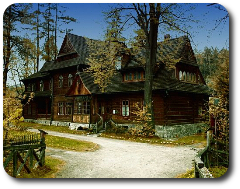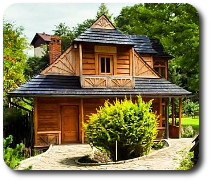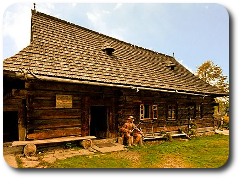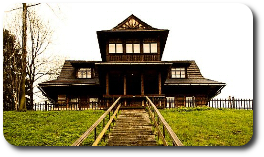LANDMARKED BUILDINGS
 Willa Koliba was the first building designed by Stanislaw Witkiewicz, the name meaning “Shepherd’s Chalet” in highlander Gwara dialect. Built on the city’s Ulica Koscieliska in 1893 by, amongst others, Klimek Bachleda, the building was extended in 1901 by adding a west wing. Notable personalities who once occupied the villa include renowned actress Helena Modrzejewska (stage name Modjeska) and famous playwright Jan Kasprowicz who wrote the poem “The wind bends orphaned spruces” while residing here in 1903. After World War II, it also served as a guest house and a children’s home which contributed to the devastation of the old building. Under the guideful eye of conservationist Zbigniew Mozdzierz, the old villa was renovated in the late 20th century and as of 1993, the building houses the Museum of Zakopane Style of architecture, dedicated to Witkiewicz.
Willa Koliba was the first building designed by Stanislaw Witkiewicz, the name meaning “Shepherd’s Chalet” in highlander Gwara dialect. Built on the city’s Ulica Koscieliska in 1893 by, amongst others, Klimek Bachleda, the building was extended in 1901 by adding a west wing. Notable personalities who once occupied the villa include renowned actress Helena Modrzejewska (stage name Modjeska) and famous playwright Jan Kasprowicz who wrote the poem “The wind bends orphaned spruces” while residing here in 1903. After World War II, it also served as a guest house and a children’s home which contributed to the devastation of the old building. Under the guideful eye of conservationist Zbigniew Mozdzierz, the old villa was renovated in the late 20th century and as of 1993, the building houses the Museum of Zakopane Style of architecture, dedicated to Witkiewicz.
 Built in 1897, Willa Pod Jedlami is often seen as a full realisation of the Witkiewicz style of architecture. The site was chosen by the architect himself and the building was financed by Jan Gwalbert Pawlikowski, a Polish economist, publicist and politician. One of the pioneers of conservation in the Tatra region. The name ‘Pod Jedlami’ (meaning under the firs) comes from the presence of the trees once growing in the garden. In the early 1970s, in was the home of Zofia and Witold Paryski, who compiled a detailed library on the subjects including Tatra flora and fauna, which were passed on to the Tatra National Park after their deaths. The exterior of the building features rock-clad walls, reaching up to 4 meters high in places, carved wooden railings and a traditionally ornamental verandah along with a well situated to the west of the villa. The interior decorated with local ornaments, originally styled furniture and regional works of art remains true to the Zakopane style.
Built in 1897, Willa Pod Jedlami is often seen as a full realisation of the Witkiewicz style of architecture. The site was chosen by the architect himself and the building was financed by Jan Gwalbert Pawlikowski, a Polish economist, publicist and politician. One of the pioneers of conservation in the Tatra region. The name ‘Pod Jedlami’ (meaning under the firs) comes from the presence of the trees once growing in the garden. In the early 1970s, in was the home of Zofia and Witold Paryski, who compiled a detailed library on the subjects including Tatra flora and fauna, which were passed on to the Tatra National Park after their deaths. The exterior of the building features rock-clad walls, reaching up to 4 meters high in places, carved wooden railings and a traditionally ornamental verandah along with a well situated to the west of the villa. The interior decorated with local ornaments, originally styled furniture and regional works of art remains true to the Zakopane style.
 Willa Atma was originally a guest house built in 1895 by Jozef Kasprus-Stoch. The name, derived from Sanscrit ‘Soul’, was given in the 1920s, as the chalet was expanded to include seven rooms. Since 1976, the villa, having been purchased by the Atma Committee and donated to the National Museum of Poland, serves as a museum dedicated to famous Polish composer, Karol Szymanowski, who lived there for several years in the 1930s before his untimely death as a result of tuberculosis. In a letter to his mother, he once described the villa as “a small, humble mountaineer’s cottage” where friends such as Artur Rubinstein often visited him, and where Szymanowski penned some of his most notable works, among others Symphony no.4 which was dedicated to Rubinstein. The interior has traditional Zakopane style decor, including two portraits by Stanislaw Witkiewicz, Young Poland’s leading painter and art theoretician. Szymanowski’s many medals of honour are on display, including the Order of Polonia Restituta, National Order of the Legion of Honour, the highest decoration in France which was established by Napeloen Bonaparte, The Order of St. Sava instituted by King Milan of Serbia to recognise meritious achievements, The Order of the Crown of Italy, The Polish Wawrzyn Akademicki honouring outstanding contribution to Polish literature and many others. The museum is located on Ulica Kasprusie, where the permanent collection, second floor library and archives can be seen, as well as occasional concerts and recitals.
Willa Atma was originally a guest house built in 1895 by Jozef Kasprus-Stoch. The name, derived from Sanscrit ‘Soul’, was given in the 1920s, as the chalet was expanded to include seven rooms. Since 1976, the villa, having been purchased by the Atma Committee and donated to the National Museum of Poland, serves as a museum dedicated to famous Polish composer, Karol Szymanowski, who lived there for several years in the 1930s before his untimely death as a result of tuberculosis. In a letter to his mother, he once described the villa as “a small, humble mountaineer’s cottage” where friends such as Artur Rubinstein often visited him, and where Szymanowski penned some of his most notable works, among others Symphony no.4 which was dedicated to Rubinstein. The interior has traditional Zakopane style decor, including two portraits by Stanislaw Witkiewicz, Young Poland’s leading painter and art theoretician. Szymanowski’s many medals of honour are on display, including the Order of Polonia Restituta, National Order of the Legion of Honour, the highest decoration in France which was established by Napeloen Bonaparte, The Order of St. Sava instituted by King Milan of Serbia to recognise meritious achievements, The Order of the Crown of Italy, The Polish Wawrzyn Akademicki honouring outstanding contribution to Polish literature and many others. The museum is located on Ulica Kasprusie, where the permanent collection, second floor library and archives can be seen, as well as occasional concerts and recitals.
 Chata Sabaly, commonly known as Sabalowka, was the family home of the well known musician and mountain guide, Jan Krzeptowski Sabala. The oldest in the region, built in the late 18th century, it is open to tourists during the summer and traditional highlander themed evenings are often organised here. Situated on Ulica Krzeptowki, it represents the oldest style of highland architecture in the region and differs from the Witkiewicz-style buildings commonly associated with the city of Zakopane. After renovation works were completed in 1979, an etnographic exhibition was assembled there by the Tatra Museum, which gave way to the current display organised by present day residents five years later, which includes the violin on which Sabala entertained the Polish elite who traveled to the region. The antique home is listed by the United Nations Educational, Scientific and Cultural Organization and part of the Wooden Architecture Trail of southern Poland which includes many national heritage sites.
Chata Sabaly, commonly known as Sabalowka, was the family home of the well known musician and mountain guide, Jan Krzeptowski Sabala. The oldest in the region, built in the late 18th century, it is open to tourists during the summer and traditional highlander themed evenings are often organised here. Situated on Ulica Krzeptowki, it represents the oldest style of highland architecture in the region and differs from the Witkiewicz-style buildings commonly associated with the city of Zakopane. After renovation works were completed in 1979, an etnographic exhibition was assembled there by the Tatra Museum, which gave way to the current display organised by present day residents five years later, which includes the violin on which Sabala entertained the Polish elite who traveled to the region. The antique home is listed by the United Nations Educational, Scientific and Cultural Organization and part of the Wooden Architecture Trail of southern Poland which includes many national heritage sites.
 The Jan Kasprowicz museum, situated next to the Sts. John the Apostle and Evangelist Church (Harenda) on the banks of the river Zakopianka, is also the place where the poet spent his last days. Purchased for 500 pounds in 1923, money he earned translating the works of Shakespeare for Winifred Cooper, an English painter, it remained the family home until the poet’s untimely death in 1926. The mausoleum is entirely made of granite imported from the lake Morskie Oko, with a roof design based on the Zakopane-style and a small bell tower. Designed by his son in law in 1933, it stands next door to the museum which was opened to the public in 1950. In the lower part of the crypt lay the ashes of Jan Kasprowicz, while the top chamber is the final resting place of his wife Maria. The museum has kept the exact same interior as when Kasprowicz lived there, with the exception of a library which was transfered to Poznan after the writer’s death and got consumed by fire. Some of his collection, however, can still be seen at the museum, along with household items used by the Kasprowicz family during their time. On the first floor of the building, there is also a gallery exhibiting the works of Karol Stryjenski, son in law of the poet, along with other paintings decorating the walls of the building.
The Jan Kasprowicz museum, situated next to the Sts. John the Apostle and Evangelist Church (Harenda) on the banks of the river Zakopianka, is also the place where the poet spent his last days. Purchased for 500 pounds in 1923, money he earned translating the works of Shakespeare for Winifred Cooper, an English painter, it remained the family home until the poet’s untimely death in 1926. The mausoleum is entirely made of granite imported from the lake Morskie Oko, with a roof design based on the Zakopane-style and a small bell tower. Designed by his son in law in 1933, it stands next door to the museum which was opened to the public in 1950. In the lower part of the crypt lay the ashes of Jan Kasprowicz, while the top chamber is the final resting place of his wife Maria. The museum has kept the exact same interior as when Kasprowicz lived there, with the exception of a library which was transfered to Poznan after the writer’s death and got consumed by fire. Some of his collection, however, can still be seen at the museum, along with household items used by the Kasprowicz family during their time. On the first floor of the building, there is also a gallery exhibiting the works of Karol Stryjenski, son in law of the poet, along with other paintings decorating the walls of the building.





